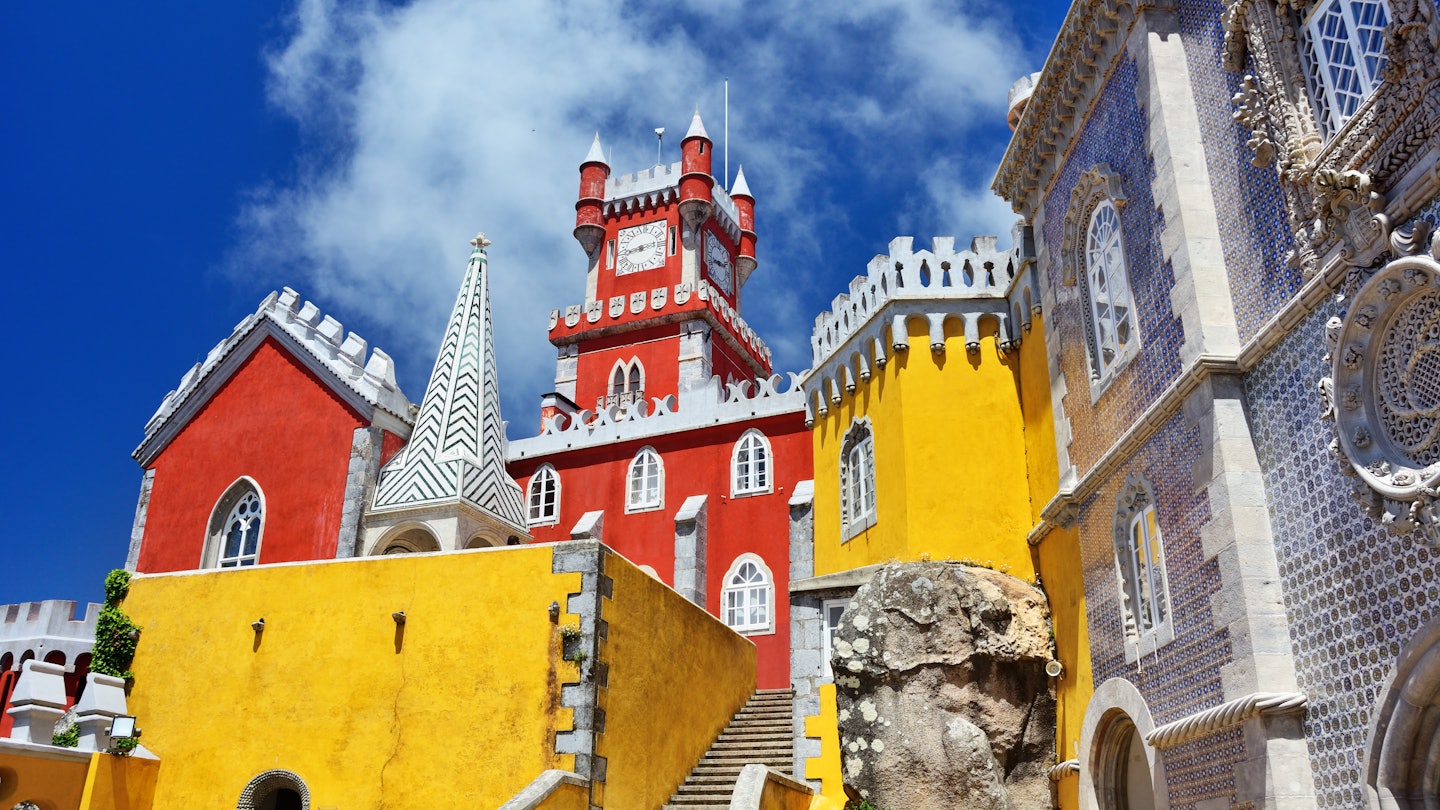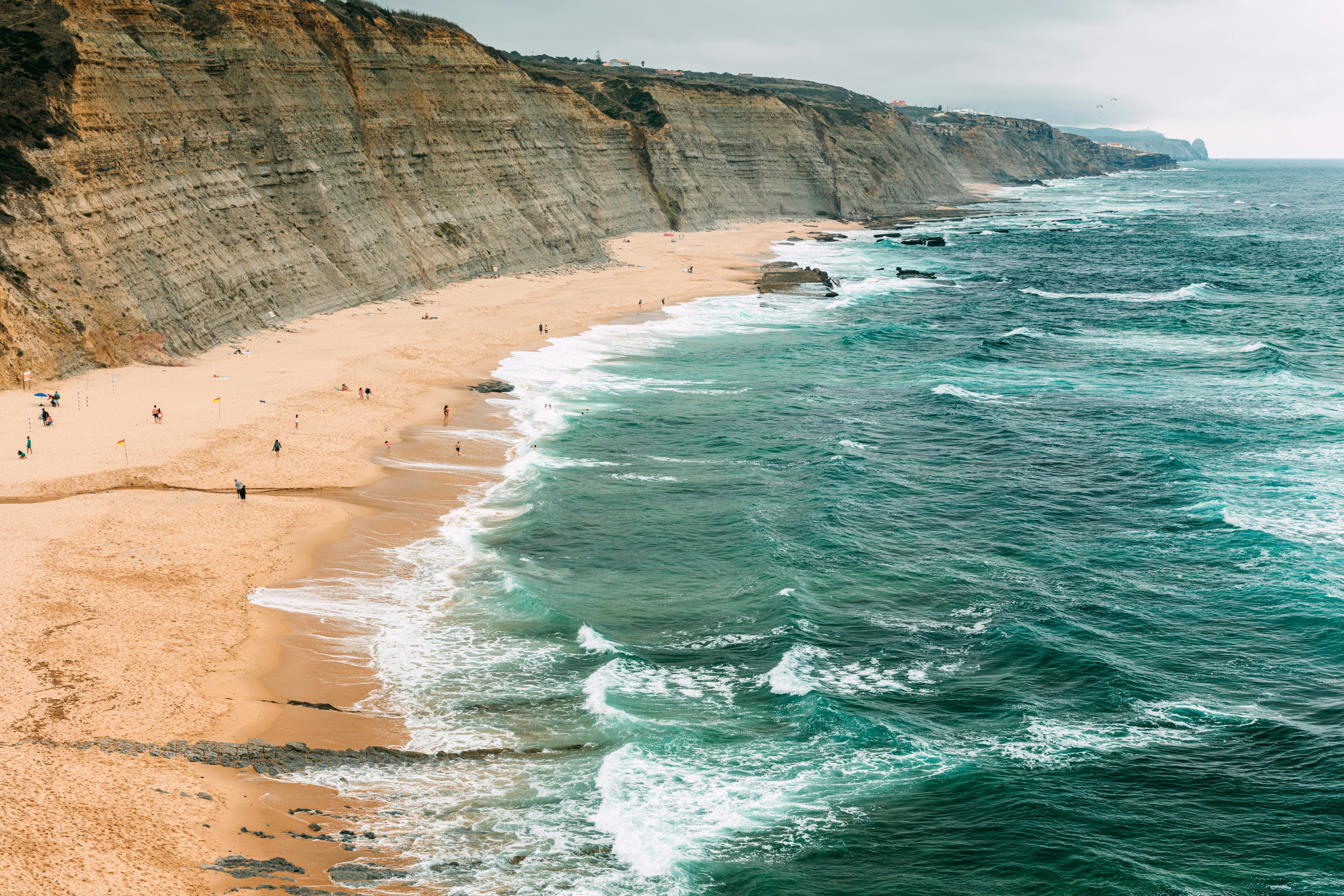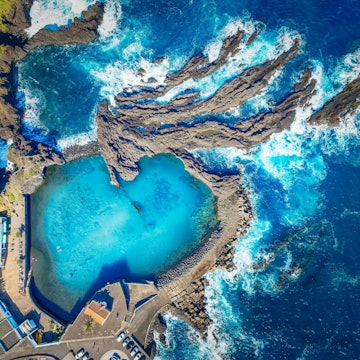

The preserved rooms at Palácio da Pena offer a glimpse into late-1800s royal life. Getty Images
A truly beautiful village and nature park, Sintra is one of the most popular places in Portugal. Only 30km (19 miles) from Lisbon, this must-see destination draws millions – yes, millions – of visitors each year.
It’s hard to resist the allure of Sintra’s famous palaces – the Palácio da Pena, the Castelo dos Mouros and Quinta da Regaleira – yet there are several other spaces and activities in the town and surrounding Parque Natural Sintra-Cascais that offer equally showstopping experiences but with fewer crowds.
These are our favorite mix of big-ticket and low-key attractions in Sintra.
1. Move like royalty through the Palácio da Pena
Palácio da Pena is Sintra's most instantly recognizable landmark. Built in 1854 by Fernando II on the bones of an old monastery, it's one of the best examples of Romanticism architecture in Europe. The palace's golden onion domes rise above dense woodland in the Sintra Mountain and inside the preserved rooms offer a glimpse into late-1800s royal life, complete with some unexpected modern touches. There's one of Europe's earliest telephone exchanges, and Portugal's first hot water shower in the king's bathroom. It's open daily to visitors for tours (€17 for adults).
Pro tip: Visit at the end of the day to avoid the crowds. You can avoid queues at the palace by purchasing your ticket through the website and receive a 15% discount if you book three days in advance.
2. Stroll through the restored gardens of Quinta da Ribafria
A property from 1541 and an example of Manueline civil architecture, Quinta da Ribafria sits on the outskirts of the Parque Natural Sintra-Cascais, about 35km (22 miles) from Lisbon. After years of abandonment, the manor opened its gates in 2015, inviting visitors to wander through its once-neglected woods and gardens.
Follow along a charming path adorned with sculptures by both Portuguese and international artists – including Stefano Beccari from Italy and Amparo Luis from Spain – or stop on one of the benches to enjoy the peace and quiet, the only sound the wind in the treetops. If you go when the estate opens at 10am, you’ll likely be one of the first there.

3. Explore the details of the Palácio and Parque Biester
Perhaps because it only opened to the public in 2022, the Palácio Biester still slips under the radar for many Sintra visitors. Together with its better-known (and busier) neighbor Quinta da Regaleira, this property, dating from the 19th century, is a textbook example of the romantic architecture that characterizes the buildings hidden within the dense Sintra forest.
The botanical park covers 6 hectares (15 acres) and boasts trees from all over the world, with stunning views of the Castelo dos Mouros and the town of Sintra from its viewpoints. The palace itself is full of original and strikking details, like the decorative paintings by the artist Luigi Manini and the French master Paul Baudry that adorn the walls and ceilings of each room. And as at other Sintra sites, mysticism and the occult are very present here, with stories of the Knights Templar and initiation chambers that feed the imagination. Budget several hours to fully appreciate the beauty of the Biester property.
Planning tip: Start your visit at the entrance on Avenida Almeida Garrett and walk through the gardens until you reach the palace. Book a 90-minute guided tour by emailing reservations@biester.pt to learn about the property’s history, or skip the queues by buying tickets online before your visit.
4. Hit the trail that leads from Villa Sassetti to the Chalet da Condessa D’Edla
This journey is not for the faint of body or spirit: almost a full day of walking along winding, uneven paths uphill from Villa Sassetti to the Chalet da Condessa d’Edla, passing the lakes of the Parque da Pena. Yet the natural beauty of the route and its countless nooks, crannies, old buildings and viewpoints will make it well worth the effort. To navigate the trails, visit the tourist office in Praça da República and ask for the maps of Villa Sassetti and Parque da Pena before embarking on your journey.
Detour: Don’t care to do the whole route or short on time? Start at the entrance to the Vale dos Lagos. Remember to bring comfortable trail shoes and water to keep you hydrated.

4. Ride the historic tram between Sintra and Praia das Maçãs
One surefire way to skip Sintra’s crowds? By hopping aboard a traditional Portuguese tram toward the coast. Built in the early 20th century, this line, leading to Praia da Maçãs, was abandoned for years before resuming service in 2004. Today, it takes local residents and visitors on an 11km (7-mile) journey across the Sintra landscape, passing houses and roads and stopping at places like the Adega Regional de Colares, in a unique 45-minute ride to the sea.
Planning tip: To get to Praia das Maçãs, take the streetcar at Rua General Alves Roçadas in Estefânia. You can buy the ticket for the ride at Vila Alda – Casa do Elétrico, located next to the streetcar stop (excluding weekends and public holidays, when you can buy it directly on the transport). When returning to Sintra, remember to get your ticket from the driver.

5. Taste fresh fish with a sea view at Azenhas do Mar
The old fishing village of Azenhas do Mar offers a simplicity, beauty and communion with the landscape that never ceases to amaze. About 10km (6 miles) from the village of Sintra and 40km (25 miles) from Lisbon, this small group of white houses perched along the cliffs seems part of a painting. Indeed, many Portuguese painters have come here for inspiration, including Júlio Pomar; arriving from Praia das Maçãs, stop at the viewpoint facing the town and you’ll understand why.
The place is small and has little parking, especially in summer. But in those warmer months, you can enjoy the natural pool on the beach at the foot of the cliff – the same beach that, being so small, loses its sand when the tide gets high. After your dip, feast on just-caught fish and seafood while enjoying the breathtaking views and beautiful sunsets at Azenhas do Mar restaurant, right by the beach.

6. Spread out your towel at Praia do Magoito
About 10km (6 miles) from Azenhas do Mar, Praia do Magoito is an excellent option to escape Sintra’s busiest beaches (such as Praia Grande or Praia das Maçãs). Along this long sandy beach that stretches along the imposing cliffs leading to Praia da Aguda, there’s plenty of space to lay out your towel. Another way to explore this landscape is to walk along the cliff-top path that links the two beaches.

7. Have a picnic at the serene Lagoa Azul
This lake is far from an unknown place – not least because of its proximity to the town of Cascais. Still, it's a great option if you’re looking for a green area to have a picnic or just take a stroll through the landscapes of the Serra de Sintra.
This serene lagoon takes on beautiful hues of green and blue as the day passes, disturbed only by the splashing of ducks in the water the sound of dogs walking by with their owners. The place is also popular as a starting point for mountain-bike rides. To enjoy the Lagoa Azul in greater peace, avoid the weekend or the month of August, and arrive early in the morning.
Planning tip: The parking lot is small and you may not find a space if you go during a busy hour. Alternatively, take the train from Lisbon to Cascais, then a taxi or Uber onward from there.

8. Take in the dazzling views from the Santuário da Peninha
At one of the highest points in Serra de Sintra – almost 500m (1640ft) above sea level – the Santuário da Peninha has the best views in the Parque Natural Sintra-Cascais.
Walk along dirt tracks until you come to the Capela de Nossa Senhora da Peninha, where you can enjoy a wide panorama of the surrounding landscape: on clear days, you can see from Cabo Espichel in the south to Cabo Carvoeiro in the north. Closer by, you can glimpse Praia do Guincho, Cascais and the Cabo da Roca lighthouse, the westernmost point of mainland Europe.
Next to the chapel is a mansion built in 1918 by the same owner of Quinta da Regaleira (closed to visitors) and, further down, an old 12th-century hermitage.
Planning tip: This area is very exposed to winds, so foggy days are frequent. Check the weather before you set off.

9. Follow the paths taken by monks at the Convento dos Capuchos
The Convento dos Capuchos (also known as the “Cork Convent” due to cork used in its construction and decoration) is a place for contemplation and introspection – appropriate for a 16th-century convent that followed the religious philosophy of the Order of St Francis of Assisi. For 250 years, Franciscan monks walked the paths that extended between large granite blocks and dense vegetation, welcoming the few men of faith who lived there and visitors alike.
As you walk these trails today, you’ll encounter chapels and hermitages that have weathered with time, yet still retain a spiritual power that will time slow your pace.
Planning tip: To make entry easier, purchase your ticket online. For an additional euro, you can get the audio-guide app, which will assist you in navigating the landmark.

10. Explore opera-worthy landscapes at Quinta da Regaleira
Designed by Italian opera set designer, Luigi Manini for a Brazilian coffee tycoon in the late 19th century, Quinta da Regaleira is an estate and palace open to visitors in Sintra's Old Town. The gardens are pure Gothic fantasia with a landscape that takes its cues from Dante's Divine Comedy, complete with secret tunnels, mysterious grottos and hidden passages. Inside the palace, the rooms are less dramatic and ornate than those of Palácio da Pena but still beautiful and interesting with their frescos and Venetian-glass mosaics. Tickets for the palace and gardens cost €15 and can be purchased online.
















